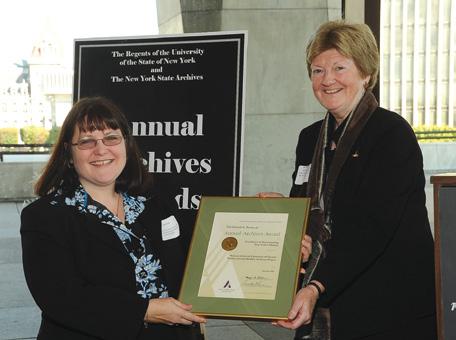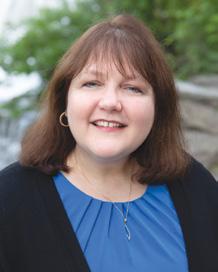
4 minute read
From the Eye of the Storm to an Eye on Community History
BY CHANA REVELL KOTZIN, PH.D.
After 17 years, Chana Revell Kotzin, Ph.D. will be leaving Jewish Buffalo. As she reflects on her time and her work throughout our community below, we wish her and her family “Lehitraot” — see you soon — as she relocates to the Midwest for new adventures.

I always thought it auspicious that my family and I arrived in Buffalo just before the “Surprise” October Storm of 2006. That event was seen by outsiders with long memories as typical of Buffalo. And for those who did not remember, the film footage of the Blizzard of 77 reminded them that Buffalo was a place of storm and snow. And while that has some resonance, we also know Buffalo as a place of neighbors and friendships. In an act that I came to know as more typical than impressive weather was the kindness of a complete stranger. I hadn’t even met Debbie Matteson before the storm, but she knew we had just relocated, and turned up on our door two days later with precious batteries and other supplies. I have never forgotten that kindness. Over the years, I had so many similar experiences that there is not enough space to list them all by name, but I remember them and thank you all.
Our lives settled as my husband Daniel took up a position at the former Medaille College. Our son, Noah began at PALS at Temple Beth Zion, and I started a parttime position at the Bureau of Jewish Education (BJE), as Director of the then fledgling Jewish Buffalo Archives Project (JBAP). This program was the inspiration of volunteer leaders Ralph Halpern and Harold Halpern (z”l) with support from the Foundation of Jewish Philanthropies (FJP) and the BJE, as well as a wonderful academic advisory committee. This decade- long initiative partnered with the University Archives and the far-sighted University Archivist of the time, John Edens, to create a public resource of over 50 archival collections. These include such varied organizations as the first congregation of Buffalo, Temple Beth El, the Jewish Community Center and its summer camps, the Jewish War Veterans loyally maintained by Maurice Sands (z”l), to the still active Hebrew Benevolent Loan Association (HBLA). It extends into rich family collections like those of David and Minnie Coplon and Rudy and Hilde Miller lovingly preserved and then donated by their descendants. It extends beyond Buffalo to neighboring Niagara Falls, and the significant records of Beth Israel, Hadassah, Rabbi Samuel Porrath and the Jewish Federation of Niagara Falls. Through support of the FJP, the BJE and multiple competitive state grants, I was able to research, locate and organize collections as well as obtain other grants to digitize hundreds of images online through NY Heritage, the first foray into the digital realm. The collections and images are used by researchers and community members daily, and the program was recognized by NY State with the Debra E. Bernhardt Award for Excellence in Documenting New York’s Heritage.
Some of these online images as well as a community call-out became the basis of my first book, Jewish Community of Greater Buffalo, published by Arcadia Press. This was a pleasure to research, write and curate. In the intervening years I worked on many volunteer projects too, that among others created histories and resources for Kadimah, Hadassah of Greater Buffalo, the Mikveh, the JCC, the HBLA and Temple Beth Zion, as well as a timeline display for Temple Beth Tzedek in the lobby of their new synagogue. The common thread throughout my work has been a commitment to partner with community members, whether I was a volunteer, a contractor or employee, to tell inclusive multi-vocal stories in their national and international contexts. In community venues, conferences, printed and online resources, and through hundreds of articles I sought to encourage and enable individuals and organizations themselves to take their own historical journeys too.
Some years later, the Jewish Buffalo History Center, powered by the Buffalo Federation, has made inclusive primary sources, written profiles, curated histories and unique online exhibitions, globally accessible, 24/7. It brings together my hopes for an ongoing public Jewish history presence for Buffalo that will live on past my tenure as well as in the partnerships of Explore Buffalo and others in process. The most recent online exhibition Sokolivka: Once Home in loving memory of Leslie Shuman Kramer, and an online and traveling version of An East Side Story: Harold Arlen’s Buffalo Roots, both produced new scholarship that continues to build connections and programs beyond our initial goals. My thanks to everyone who contributes to the Jewish Buffalo History Center. Without the participation of you who have shared materials, this would not have been possible or such a success.
My work at the Cofeld Judaic Museum at Temple Beth Zion was another passion project that was rewarding on multiple levels, not least in the resource it provides for temple and community members, architecture aficionados, as well as to all who seeks to learn about Judaism and Jewish history, young and old, Jewish and non-Jewish. Reimagining this museum and devising new ways to think about the display of global Jewish history in the context of a living synagogue was so rewarding. It was brought to fruition in cooperation with a devoted team of lay leaders and professionals. I look forward to continuing my work with the Cofeld remotely.
Daniel and I never expected to leave
Buffalo. This is where we bought our first home and raised our son. But life has a different plan. With the demise of Medaille, our family leaves Buffalo for the Midwest. My parents, of blessed memory, would never have predicted the life that I have had since arriving in America. I had a peripatetic childhood and adulthood in the UK, Australia and Israel. I followed in my mother’s, grandmother’s and great grandmother’s footsteps as part of a chain of women immigrants living in eight separate countries but sharing the UK and Israel as homes in common to us all. I’ve lived in four cities in America over twenty-five years. That I settled in one place for almost 17 years would have amazed my forebears, given their own experiences of repeated relocations. Reflecting on the idea of home, identity and rootedness, I think it ironic and yet predictable that I ended up specializing in local history.
As I complete my second book on the history of Jewish Buffalo in the next year, I will continue to treasure friendships with the families and individuals I have had the pleasure to work and grow with through my many roles here. While I depart Buffalo in a physical sense, I remain connected to the generosity of spirit I have found in this Queen City on the Lake, and I will miss you all.









